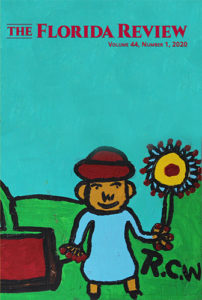The Florida Review – Summer 2010
Volume 35 Number 1
Summer 2010
Biannual
Sima Rabinowitz
The journal’s first-ever special issue is a “Native Issue,” with contributions by writers “from many different places—tribal, geographic, aesthetic,” including writers who grew up in the Laguna Pueblo, and members of the Diné, Mi’kmaq Métis, Cherokee, Kanien ‘kehaka, Onodowaga, Yappituka Comanche/Southern Araphaho, Turtle Mountain Chippewa, Arkansas Quapaw, Poarch Creek/Muscogee, Fond du Lac Band of Lake Superior Ojibwe, Oglala Lakota, Seneca, Sioux, Acoma Pueblo, Apache, and Chicasaw tribes and nations. These writers’ work is as distinct and diverse as the communities and nations into which they were born and/or have lived.
The journal’s first-ever special issue is a “Native Issue,” with contributions by writers “from many different places—tribal, geographic, aesthetic,” including writers who grew up in the Laguna Pueblo, and members of the Diné, Mi’kmaq Métis, Cherokee, Kanien ‘kehaka, Onodowaga, Yappituka Comanche/Southern Araphaho, Turtle Mountain Chippewa, Arkansas Quapaw, Poarch Creek/Muscogee, Fond du Lac Band of Lake Superior Ojibwe, Oglala Lakota, Seneca, Sioux, Acoma Pueblo, Apache, and Chicasaw tribes and nations. These writers’ work is as distinct and diverse as the communities and nations into which they were born and/or have lived.
There isn’t a piece in the issue that doesn’t merit mention, but for the sake of this brief review, I’ll select some highlights. For me, these include Geary Hobson’s story “Arrowhead,” a fictional account of marines training in the San Bernardino mountains; a novel excerpt from one of the best-loved, most respected writers/scholars of Native life Gerald Vizenor, “Captain Eighty,” in which he creates characters we want to know more about and who seem believable and worth our attention; poems by Denise K. Lajimodiere and Tiffany Midge; nonfiction from Sara Marie Ortiz, who merges a consideration of language and environment in “Penumbra and Thrum”; and “A Conversation” between Santee Frazier and Sherwin Bitsui.
Midge’s “Ten Ways to Consider the Great Spirit,” counts backwards from 10-1 with a powerful personal story: “After the ventilator was finally removed, after we had held our collective breath, waited for the monitors—heartbeat, respiration—to wind slowly down, then stop, I made my goodbyes, then left.” Midge has a masterful sense of rhythm and timing. Lajimodiere has an urgent and elegant lyrical impulse that results in poetry of great immediacy and impact (I am tempted to say “frigid impact”):
The moon of bone crackling cold,
Of Styrofoam crunch snow,
The snow blind moon
The moon of white outs,
Short days, long nights,
The moon of blizzards,
of popping tree limbs,
The moon of thirty days below zero,
of wind chill advisories,
frostbit, blackened skin,
The moon of frozen lakes,
The least heat moon,
The moon of white suns, communion discs,
The Alberta clippers moon
In his conversation with Bitsui, Santee Frazier says he is in the process of relearning the Cherokee language of his family. I am certain he is (or will be) as eloquent and clever in Cherokee (we must, must, must preserve these languages) as he is in English:
Mangled was lost in the city, roaming
the alleys, trudging toward signs he saw:
TRUE LOVE’S, BIG RED, CRAZY HORSE,
THE FORGET IT.
Get lost (read with abandon and appreciation) this memorable issue of The Florida Review.
[www.floridareview.cah.ucf.edu]


